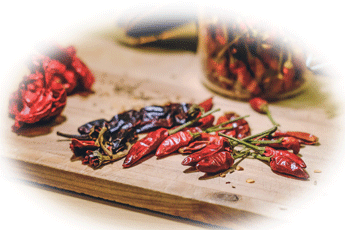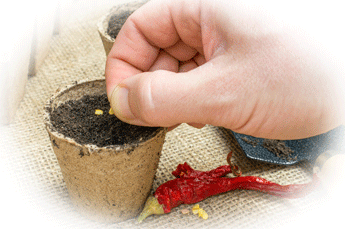 Getting seeds right
Getting seeds right
I want to become far more scientific in my approach to growing Chillies. As part of this, I want to examine everything required to grow them in finer detail. I will examine Chilli seeds, potting soils, water, fertilizers, growing temperatures and anything else needed. The aim here is to get a fresh perspective and build on what I already have learned about growing Chillies.
Matters surrounding seeds are probably some of the most important decisions that need to be taken in growing Chillies successfully. Seeds are after all the beginning of the whole process, so it is essential to get them right. If you can do that, everything else rest will fall into place.
So, isn’t choosing seeds just about using seeds saved from last year, getting them as a gift from a friend, or buying them online or at a garden centre? Not really! There is a lot more that needs to be considered. Where we buy our seeds, susceptibility to diseases, which varieties to plant, and growing conditions ( amongst other factors) need to be taken into account.
This post discusses that in detail. It covers what needs to be considered when buying seeds, and also what seeds need to grow healthily and with vigour. It also discusses how important it is to be selective in who and where we get our seeds from if we want to prevent the spread of Chilli plant diseases in the United Kingdom .
About seeds. The basics

What is a seed?
A seed is an embryo with a store of nutrients wrapped in a hard outer shell. This embryo will burst in life when temperature, moisture and soil conditions are favourable. Nature has equipped seeds to sense when the conditions are right for it to wake up and become a seedling.
These conditions need to meet specific criteria before seeds will react. For example, the temperature needs to fall into a range where it is neither too cold nor hot for the seeds to germinate. The lower the temperature, the slower the germination rate will be. The higher the temperature, the faster the germination, but at a less successful rate. Where conditions fall just between these two extremes, germination will occur rapidly and have a greater rate of success. For me, the ideal temperature to germinate Chilli seeds is between 26 and 29 degrees Celsius. Others may go lower and start at 22 degrees Celsius.
germination rate will be. The higher the temperature, the faster the germination, but at a less successful rate. Where conditions fall just between these two extremes, germination will occur rapidly and have a greater rate of success. For me, the ideal temperature to germinate Chilli seeds is between 26 and 29 degrees Celsius. Others may go lower and start at 22 degrees Celsius.
The seed starting compost they are started in should also be suitable for seed germination. If the compost is too sandy or too dense, it will not be conducive to good germination. The soil should be light and fine textured. If the compost has these qualities, it will provide the seed with the air it needs to germinate. The moisture in the soil should also be just right. It the soil has too much water, air supply to the seed will be restricted. Under these circumstances, the seed will not germinate. It is even possible that seed may drown.
When there is good seed to soil contact, enough moisture and the right temperature range seeds will germinate. That is of course, if they are viable Seeds have a shelf life. It is essential to ensure that the seeds are not too old. As a general rule, seeds from one season to the other will usually germinate, but if it goes longer than that (particularly after a couple of years), germination rates will start falling off
Another consideration is that many seeds germinate best in the dark. However, once the seedlings have germinated, it is essential that they are placed under a source of light. Not doing so would mean they would become leggy as they search for light.
So what needs to be considered?

Weather & quality of seeds
The weather conditions of the region where Chillies are grown are a definite consideration. If you grow in a colder part of the country, you may want to consider growing cold weather resistant varieties. Chillies like Rocotos are cold weather resistant. Growing these types of Chillies in cold regions will lead to more chances of success. In warmer areas that get lots of sunshine, the options become far wider
The next consideration is the quality of the seeds you plant. I would recommend only buying from seed companies that can vouch for the quality of their seeds. You will find many seed companies on the web offering cut price seeds. In many instances, this means only one thing. The seeds are not good. They may be old, and in some cases not even what you think they are. You might buy a seed advertised as a particular variety, only to find it is something else once you have grown it.
Furthermore, seeds can harbour diseases. If you choose a seed supplier that has not been successful in ensuring their seeds have been through a vigorous quality control procedure, you may be creating massive problems for yourself. You may find your other plants infected with diseases that the non-quality controlled seeds introduce.
One particular disease that has created alarm among Chilli growers is called Tomato Brown Rugose. This disease attacks Chillies and tomatoes. It was first identified in Israel in 2014, but has since spread around the world to countries like China, Germany, Greece, Italy, Jordan, Palestine, Saudi Arabia, and Turkey. There have been isolated outbreaks of the in the United Kingdom.
Why take the risk? Rather choose seeds from a reputable seed supplier. In that way, you can start the season with confidence, knowing that all the time and effort you will invest will be rewarded. You may save money buying from cheaper sources, but is it worth it? After all, you get what you pay for!
Finally
Final considerations
When you save seeds from your own growing, always make sure the seeds you save are from your healthiest plants. You don’t want to carry diseases over from one season to the next.
Similarly, if you have a friend who has given you seed, make sure they are confident it is from a healthy plant. If it is seed that they have not grown themselves, I would also ask where the seeds come from. If it is seed gathered from a plant in the wild, don’t touch it with a bargepole. Similarly, if the seed has been bought online or at a supermarket, ensure the source that has provided it is trustworthy.
